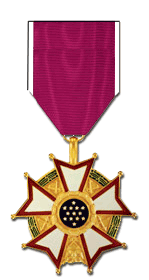 Establishing Authority
Establishing Authority
The Legion of Merit was established by Act of Congress (Public Law 671, 77th Congress) approved July 20, 1942, and by Executive Order 9260 signed on October 29, 1942, by President Franklin D. Roosevelt.
Effective Dates
Award of the Legion of Merit is retroactive to September 8, 1939.
Criteria
The Legion of Merit is awarded to members of the Armed Forces of the United States without degree for exceptionally outstanding conduct in the performance of meritorious service to the United States. The performance must merit recognition by individuals in a key position which was performed in a clearly exceptional manner. The performance of duties normal to the grade branch, specialty or assignment and experience of an individual is not an adequate basis for this award.
For service rendered in peacetime, the term "key individual" applies to a narrower range of positions than would be the case in time of war and requires evidence of significant achievement. In peacetime, service should be in the nature of a special requirement or of an extremely difficult duty performed in an unprecedented and clearly exceptional manner. However, justification of the award may accrue by virtue of exceptionally meritorious service in a succession of important positions.
Order of Precedence
The Legion of Merit is awarded to members of the Armed Forces of the United States without degree and is worn after the Defense Superior Service Medal and before the Distinguished Flying Cross.
Awards to members of foreign armed forces are made in the degree of Chief Commander, Commander, Officer, and Legionnaire. The first two degrees are comparable in rank to the Distinguished Service Medal and are usually awarded to heads of state and to commanders of armed forces, respectively. The last two degrees are comparable in rank to the award of the Legion of Merit to United States service members
Devices
Designer and Sculptor
The Legion of Merit was designed by Colonel Ralph Townsend Heard and sculpted by Katharine W. Lane of Boston, Massa-chusetts.
First Recipients
- The first American recipient of the Legion of Merit was Lieutenant (Junior Grade) Ann Agnes Bernatitus, USN, whose award was approved on October 14, 1942 based on her service as a nurse during the campaign in the Manila-Bataan Peninsula areas from December of 1941 to April of 1942.
- The first foreign recipient of the Legion of Merit in the grade of Legionnaire was Lieutenant de Vaisseau A. Bergeret of the Free French Navy and commander of the Corvette Roselys, whose award was approved on October 27, 1942.
- The first foreign recipient of the Legion of Merit in the grade of Officer was Colonel Johanes K. Meijer of the Royal Netherlands Army in Surinam.
- The first recipient of the Legion of Merit in the grade of Commander was Brigadier General Amaro Soares Bittencourt of Brazil, who received his award at Miami, Florida on November 7, 1942.
- The first person to receive the Legion of Merit in the grade of Chief Commander was General Sir Kenneth A.N. Anderson, the British Army commander in North Africa, who received his award on June 18, 1943.
Description and Symbolism
Obverse
A five-armed white enameled cross of ten points, each point tipped with a gold ball. The cross is bordered in American Beauty red enamel. In the center of the cross, thirteen stars on a blue field are surrounded by a circle of heraldic clouds. Between the arms of the cross, a laurel wreath is tied in a bow between the two lower arms of the cross. Between the wreath and the center of the medal, situated in each re-entrant angle of the cross, are two crossed arrows pointing outward.
The basic physical form and name of the Legion of Merit was adapted from the French Legion of Honor, which is also a white enameled cross of five arms tipped with balls. The field of thirteen stars surrounded by clouds is taken from the reverse of the Great Seal of the United States and represents the "new constellation," the description of the young republic used by the Founding Fathers. The laurel wreath alludes to achievement, and the arrows pointing outward represent armed protection of the nation.
Reverse
The same cross appears on the reverse, except it is not enameled. In the center of the cross is a blank circular space defined by a rope border to be used for engraving the recipient's name. Contained within a second rope border (forming a space between the two), the raised inscription, ANNUIT COEPTIS MDCCLXXXII with each word being separated by a bullet. In place of the wreath that appears on the obverse, there is a band bearing the raised inscription, UNITED STATES OF AMERICA, each word also separated by a bullet. In the re-entrant angles of the cross, in the space between the band and the center of the medal, are two crossed arrows pointing outward.
The words ANNUIT COEPTIS (He [God] Has Favored Our Undertaking) is taken from the front of the Great Seal of the United States, and the date MDCCLXXXII (1782) refers to the year General George Washington founded the Badge of Military Merit, from which the Legion of Merit is descended. .
Ribbon
The ribbon is purple-red (American Beauty Red) edged in white. The color is modified from that of the Purple Heart, which is also derived from General George Washington's Badge of Military Merit.